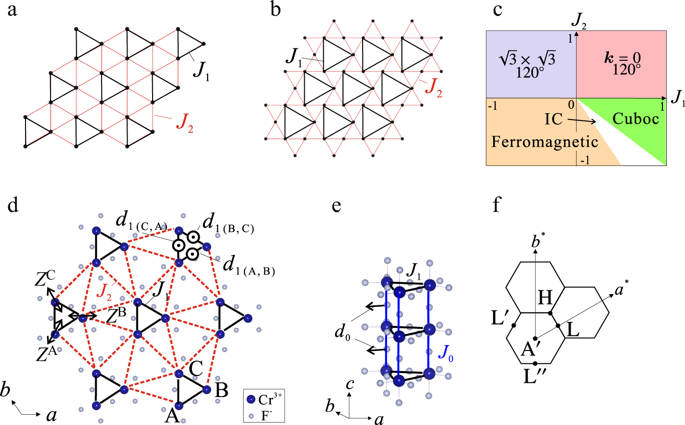npj Quantum Materials ( IF 5.7 ) Pub Date : 2019-04-23 , DOI: 10.1038/s41535-019-0152-5 Masato Hagihala , Shohei Hayashida , Maxim Avdeev , Hirotaka Manaka , Hodaka Kikuchi , Takatsugu Masuda

|
When a theoretical model is realized in nature, small perturbation terms play important roles in the selection of the ground state in geometrically frustrated magnets. In case of a triangular spin tube, the two-dimensional network of the inter-tube interaction forms characteristic lattices. Among them Kagome-Triangular (KT) lattice is known to exhibit an enriched phase diagram including various types of non-trivial structures: non-coplanar cuboc structure, coplanar 120° structure with the two-dimensional propagation vector of \({\boldsymbol{k}}_{2\mathrm{D}}\) = (0, 0), \(\sqrt 3 \times \sqrt 3\) structure with \({\boldsymbol{k}}_{2{\mathrm{D}}}\) = (1/3, 1/3), and incommensurate structure. We investigate the magnetic state in the model material CsCrF4 by using neutron diffraction technique. Combination of representation analysis and Rietveld refinement reveals that a very rare structure, i.e., a quasi-120° structure with \({\boldsymbol{k}}_{2{\mathrm{D}}}\) = (1/2, 0), is realized at the base temperature. The classical calculation of the phase diagram elucidates that CsCrF4 is the first experimental realization of the KT lattice having ferromagnetic Kagome bond. A single-ion anisotropy and Dzyaloshinskii-Moriya interaction play key roles in the selection of the ground state. Furthermore, a successive phase transition having an intermediate state represented by \({\boldsymbol{k}}_{2{\mathrm{D}}}\) = (1/3, 1/3) is observed. The intermediate state is a partially ordered 120° structure which is induced by thermal fluctuation.
中文翻译:

CsCrF 4中具有受挫几何形状的耦合自旋管的磁态
当在自然界中实现理论模型时,小的扰动项在几何受挫的磁体的基态选择中起着重要作用。在三角形旋转管的情况下,管间相互作用的二维网络形成特征晶格。其中已知Kagome-三角形(KT)晶格具有丰富的相图,其中包括各种类型的非平凡结构:非共面立体结构,共面120°结构以及二维传播矢量\({\ boldsymbol { k}} _ {2 \ mathrm {D}} \) =(0,0),\(\ sqrt 3 \ times \ sqrt 3 \)结构具有\({\ boldsymbol {k}} _ {2 {\ mathrm {D}}} \) =(1/3,1/3),并且结构不相称。我们研究了模型材料CsCrF中的磁态4.采用中子衍射技术。表示分析和Rietveld改进的组合表明,非常稀有的结构,即具有\({\ boldsymbol {k}} _ {2 {\ mathrm {D}}} \} \) =(1/2的准120°结构,0)是在基准温度下实现的。相图的经典计算阐明了CsCrF 4是具有铁磁Kagome键的KT晶格的第一个实验实现。单离子各向异性和Dzyaloshinskii-Moriya相互作用在基态选择中起关键作用。此外,具有由\({\ boldsymbol {k}} _ {2 {\ mathrm {D}}} \\}表示的中间状态的连续相变 =(1 / 3,1 / 3)。中间状态是由热波动引起的部分有序的120°结构。


























 京公网安备 11010802027423号
京公网安备 11010802027423号